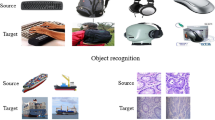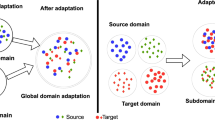Abstract
Domain adaptation aims to minimize the mismatch between the source domain in which models are trained and the target domain to which those models are applied. Most existing works focus on instance reweighting, feature representation, and classifier learning independently, which are ineffective when the domain discrepancy is substantially large. In this study, we propose a new unified hybrid approach that takes advantage of Lie group theory, weighted distribution alignment, and manifold alignment, which are referred to as Lie Group Manifold Analysis (LGMA). LGMA mainly finds a one-parameter sub-group decided by the Lie algebra elements of the intrinsic mean of all samples, and this one-parameter sub-group is a geodesic on the original Lie group. Moreover, the Lie group samples are projected onto the geodesics to maximize the separability of the projected samples for realizing discrimination in the nonlinear Lie group manifold space. As far as we know, LGMA is the first attempt to perform Lie algebra transformation to project the original features in the Lie group space onto Lie algebra manifold space for domain adaptation. Comprehensive experiments validate that our approach considerably outperforms competitive methods on real-world datasets.






Similar content being viewed by others
References
Kim S, Jeong M, Ko BC (2020) Energy efficient pupil tracking based on rule distillation of cascade regression forest. Sensors 20(18):5141
Weiss K, Khoshgoftaar TM, Wang D (2016) A survey of transfer learning. J Big Data 3(1):1–40
Pan J, Yang Q (2010) A survey on transfer learning. IEEE Trans Knowl Data Eng 22(10):1345–1359
Xing FZ, Pallucchini F, Cambria E (2019) Cognitive-inspired domain adaptation of sentiment lexicons. Inf Process Manag 56(3):554–564
Zhao C, Wang S, Li D (2020) Multi-source domain adaptation with joint learning for cross-domain sentiment classification. Knowl-Based Syst 191:105254
Long M, Wang J, Ding G, Pan SJ, Yu PS (2014) Adaptation regularization: A general framework for transfer learning. IEEE Trans Knowl Data Eng 26(5):1076–1089
Chong Y, Peng C, Zhang C, Wang Y, Feng W, Pan S (2021) Learning domain invariant and specific representation for cross-domain person re-identification. Appl Intell:1–14
Lee C-Y, Batra T, Baig MH, Ulbricht D (2019) Sliced wasserstein discrepancy for unsupervised domain adaptation. In: Proceedings of the IEEE Conference on Computer Vision and Pattern Recognition, pp 10285–10295
Khan MAAH, Roy N, Misra A (2018) Scaling human activity recognition via deep learning-based domain adaptation. In: 2018 IEEE International Conference on Pervasive Computing and Communications (PerCom). IEEE, pp 1–9
Ziser Y, Reichart R (2018) Pivot based language modeling for improved neural domain adaptation. In: Proceedings of the 2018 Conference of the North American Chapter of the Association for Computational Linguistics: Human Language Technologies, Volume 1 (Long Papers), pp 1241–1251
Quanz B, Huan J, Mishra M (2012) Knowledge transfer with low-quality data: A feature extraction issue. IEEE Trans Knowl Data Eng 24(10):1789–1802
Si S, Tao D, Geng B (2010) Bregman divergence-based regularization for transfer subspace learning. IEEE Trans Knowl Data Eng 22(7):929–942
Wei P, Ke Y, Goh CK (2016) Deep nonlinear feature coding for unsupervised domain adaptation. In: Proceedings of the Twenty-Fifth International Joint Conference on Artificial Intelligence, pp 2189–2195
Donahue J, Jia Y, Vinyals O, Hoffman J, Zhang N, Tzeng E, Darrell T (2014) Decaf: A deep convolutional activation feature for generic visual recognition. Int Conf Mach Learn:647–655
Bendavid S, Blitzer J, Crammer K, Kulesza A, Pereira F, Vaughan JW (2010) A theory of learning from different domains. Mach Learn 79(1):151–175
Ma Z, Yang Y, Nie F, Sebe N, Yan S, Hauptmann AG (2014) Harnessing lab knowledge for real-world action recognition. Int J Comput Vis 109(1):60–73
Li S, Song S, Huang G, Ding Z, Wu C (2018) Domain invariant and class discriminative feature learning for visual domain adaptation. IEEE Trans Image Process PP(99):1–1
Huang J, Zhou Z (2019) Transfer metric learning for unsupervised domain adaptation. IET Image Process 13(5):804–810
Li J, Jing M, Lu K, Zhu L, Shen HT (2019) Locality preserving joint transfer for domain adaptation. IEEE Trans Image Process 28(12):6103–6115
Li J, Lu K, Huang Z, Zhu L, Shen HT (2018) Transfer independently together: A generalized framework for domain adaptation. IEEE Trans Cybern 49(6):2144–2155
Qin C, Wang L, Zhang Y, Fu Y (2019) Generatively inferential co-training for unsupervised domain adaptation. In: 2019 IEEE/CVF International Conference on Computer Vision Workshop (ICCVW). IEEE, pp 1055–1064
Ahmadvand M, Tahmoresnezhad J (2021) Metric transfer learning via geometric knowledge embedding. Appl Intell 51:921–934
Hoffman J, Rodner E, Donahue J, Darrell T, Saenko K (2013) Efficient learning of domain-invariant image representations. International Conference on Learning Representations
Zhu F, Shao L (2014) Weakly-supervised cross-domain dictionary learning for visual recognition. Int J Comput Vis 109(1):42–59
Gholenji E, Tahmoresnezhad J (2020) Joint discriminative subspace and distribution adaptation for unsupervised domain adaptation. Appl Intell 50(7):2050–2066
Fisher RA (1936) The use of multiple measurements in taxonomic problems. Ann Eugen 7(2):179–188
Baktashmotlagh M, Harandi MT, Lovell BC, Salzmann M (2014) Domain adaptation on the statistical manifold. In: 2014 IEEE Conference on Computer Vision and Pattern Recognition. IEEE, pp 2481–2488
Pan SJ, Tsang IW, Kwok JT, Yang Q (2010) Domain adaptation via transfer component analysis. IEEE Trans Neural Netw 22(2):199–210
Ben-David S, Blitzer J, Crammer K, Pereira F (2006) Analysis of representations for domain adaptation. In: International Conference on Neural Information Processing Systems
Fernando B, Habrard A, Sebban M, Tuytelaars T (2014) Unsupervised visual domain adaptation using subspace alignment. In: IEEE International Conference on Computer Vision, pp 2960–2967
Gong B, Shi Y, Sha F, Grauman K (2012) Geodesic flow kernel for unsupervised domain adaptation. In: 2012 IEEE Conference on Computer Vision and Pattern Recognition. IEEE, pp 2066– 2073
Gopalan R, Li R, Chellappa R (2011) Domain adaptation for object recognition: An unsupervised approach. In: 2011 international conference on computer vision. IEEE, pp 999– 1006
Cui Z, Chang H, Shan S, Chen X (2014) Generalized unsupervised manifold alignment. In: Advances in Neural Information Processing Systems, pp 2429–2437
Shao M, Castillo C, Gu Z, Fu Y (2012) Low-rank transfer subspace learning. In: 2012 IEEE 12th International Conference on Data Mining. IEEE, pp 1104–1109
Ben-David S, Blitzer J, Crammer K, Pereira F (2010) Manifold alignment via corresponding projections. In: British Machine Vision Conference, pp 1–11
Cao Y, Long M, Wang J (2018) Unsupervised domain adaptation with distribution matching machines.. In: AAAI, pp 2795– 2802
Vapnik VN (1999) An overview of statistical learning theory. IEEE Trans Neural Netw 10 (5):988–999
Tuzel O, Porikli F, Meer P (2008) Learning on lie groups for invariant detection and tracking. In: 2008 IEEE Conference on Computer Vision and Pattern Recognition. IEEE, pp 1– 8
Li F, Zhang L, Zhang Z (2018) Lie group machine learning. Walter de Gruyter GmbH & Co KG
Ghifary M, Balduzzi D, Kleijn WB, Zhang M (2017) Scatter component analysis: A unified framework for domain adaptation and domain generalization. IEEE Trans Pattern Anal Mach Intell 39(7):1414–1430
Zhang J, Li W, Ogunbona P (2017) Joint geometrical and statistical alignment for visual domain adaptation. In: Proceedings of the IEEE Conference on Computer Vision and Pattern Recognition, pp 1859–1867
Long M, Wang J, Ding G, Sun J, Yu PS (2014) Transfer feature learning with joint distribution adaptation. In: IEEE International Conference on Computer Vision, pp 2200–2207
Wang J, Feng W, Chen Y, Yu H, Huang M, Yu PS (2018) Visual domain adaptation with manifold embedded distribution alignment. In: Proceedings of the 26th ACM international conference on Multimedia, pp 402–410
Georgi H, Jagannathan K (1983) Lie algebras in particle physics. Phys Today 36(12):62–62
Hall BC (2015) Lie groups, lie algebras, and representations. Springer Berl 659(5):xiv,351
Quanz B, Huan J (2009) Large margin transductive transfer learning. In: Acm Conference on Information & Knowledge Management
Wang J, Chen Y, Hao S, Feng W, Shen Z (2017) Balanced distribution adaptation for transfer learning. In: IEEE International Conference on Data Mining
Belkin M, Niyogi P, Sindhwani V, Bartlett P (2006) Manifold regularization: a geometric framework for learning from examples. J Mach Learn Res 7(1):2399–2434
Saenko K, Kulis B, Fritz M, Darrell T (2010) Adapting visual category models to new domains. In: European Conference on Computer Vision, pp 213–226
Fang C, Xu Y, Rockmore DN (2014) Unbiased metric learning: On the utilization of multiple datasets and web images for softening bias. In: IEEE International Conference on Computer Vision, pp 1657–1664
Suykens JAK, Vandewalle J (1999) Least squares support vector machine classifiers. Neural Process Lett 9(3):293–300
Long M, Wang J, Ding G, Sun J, Yu PS (2014) Transfer joint matching for unsupervised domain adaptation. In: Computer Vision and Pattern Recognition, pp 1410– 1417
Acknowledgments
This work was supported in part by the Key-Area Research and Development Program for Guangdong Province (2019B010136001) and the National Key Research and Development Plan under Grant 2017YFB0801801, in part by the National Natural Science Foundation of China (NSFC) under Grant 61672186 and Grant 61872110.
Author information
Authors and Affiliations
Corresponding author
Additional information
Publisher’s note
Springer Nature remains neutral with regard to jurisdictional claims in published maps and institutional affiliations.
Rights and permissions
About this article
Cite this article
Yang, H., He, H., Zhang, W. et al. Lie group manifold analysis: an unsupervised domain adaptation approach for image classification. Appl Intell 52, 4074–4088 (2022). https://doi.org/10.1007/s10489-021-02564-3
Accepted:
Published:
Issue Date:
DOI: https://doi.org/10.1007/s10489-021-02564-3




